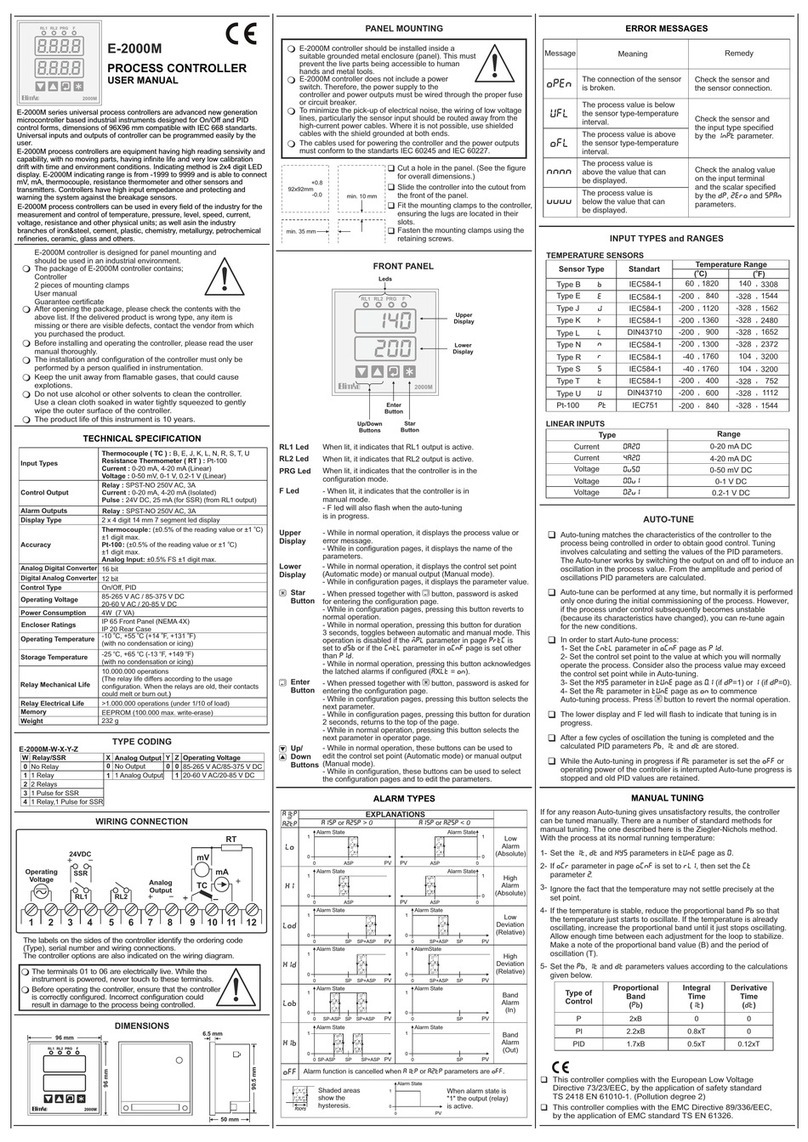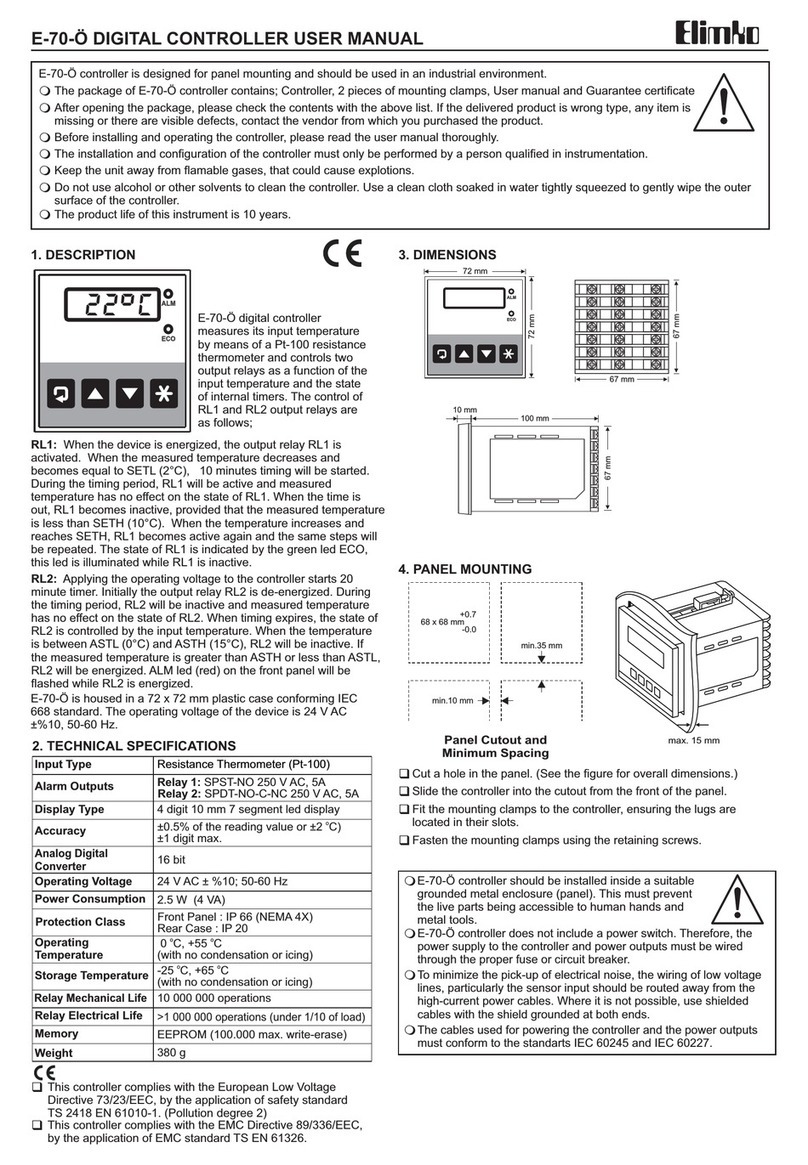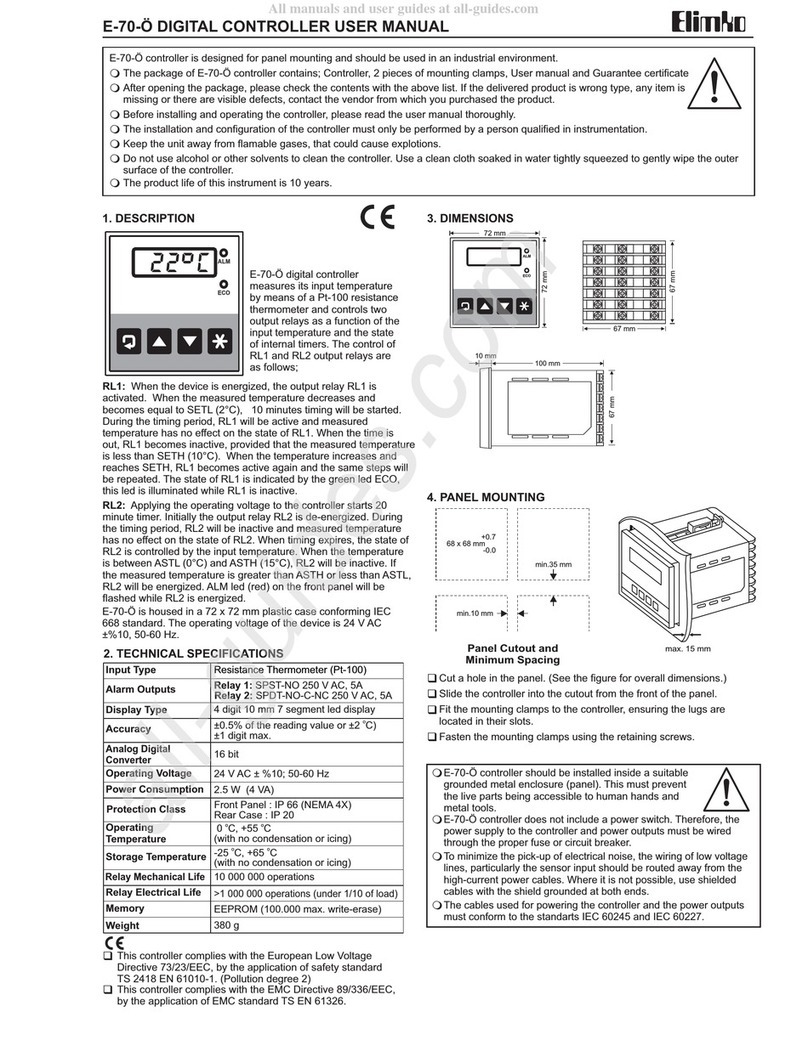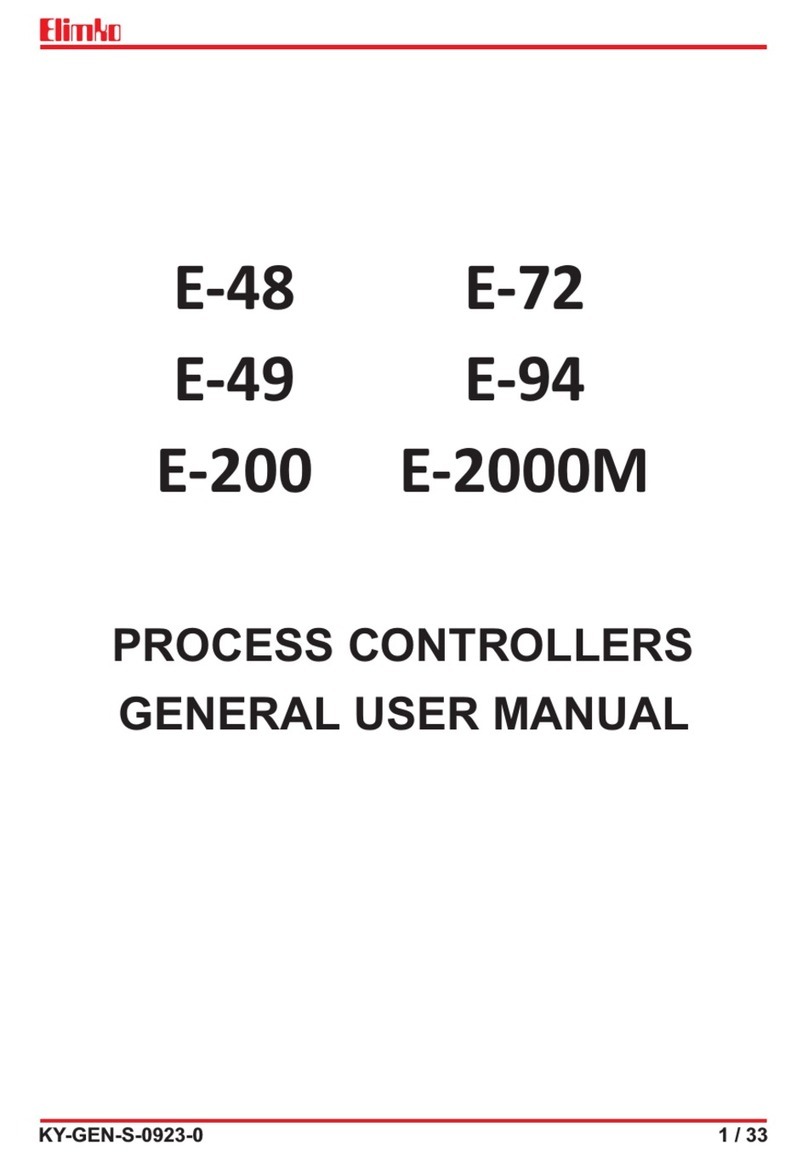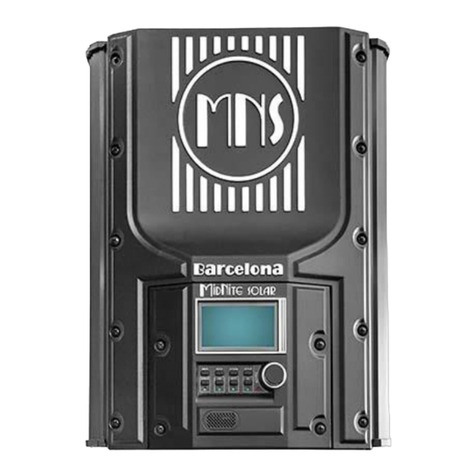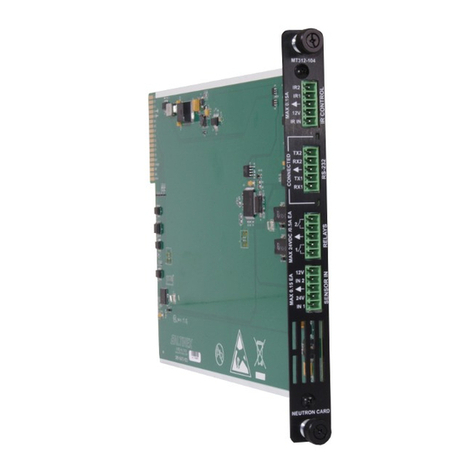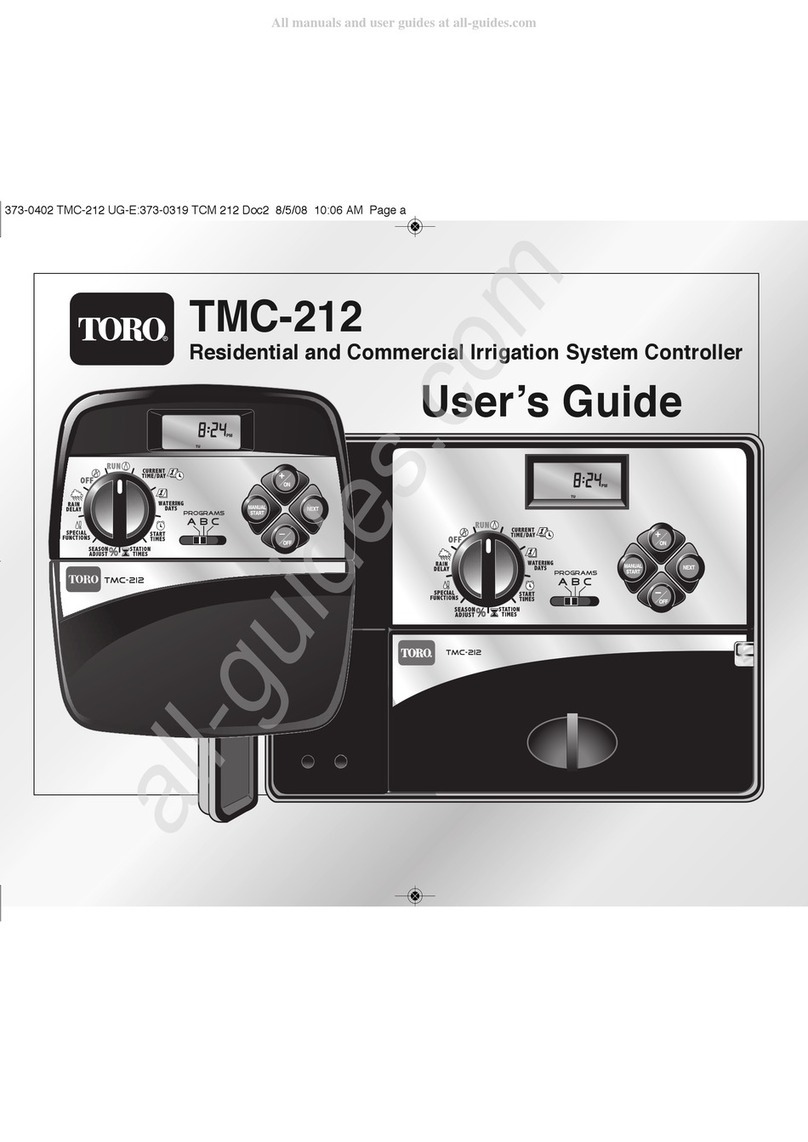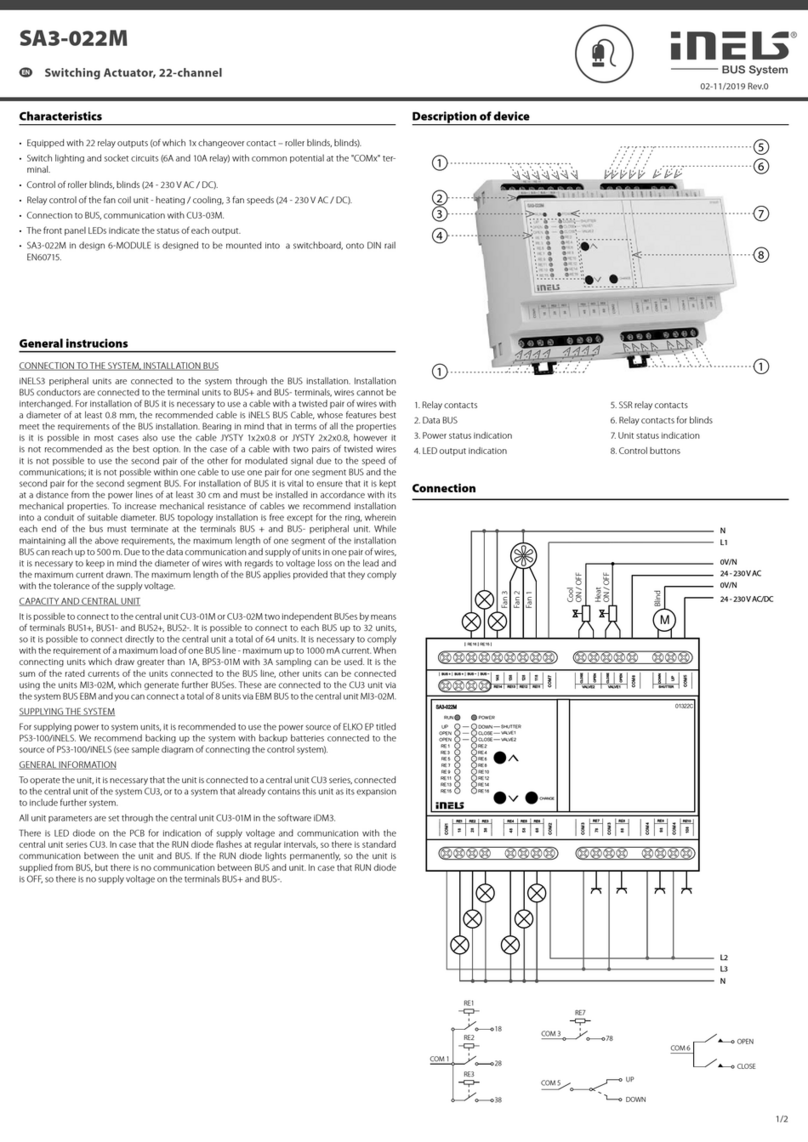Elimko E-48 User manual

CONNECTION DIAGRAM
01
85-265 VAC ; 50 - 60Hz / 85-375 VDC
20-60 VAC ; 50 - 60Hz / 20-85 VDC
02
03
04
05
06
07
08
09
10
13 14
11 12
TC
mA RT
Tx
+24V
RL1 RL2
BA
RS-485
Tx
GND
E-48
mV
E-48 controller should be installed inside a suitable
grounded metal enclosure (panel). This must
prevent the live parts being accessibleto human
hands and metal tools.
E-48 controller does not include a power switch.
Therefore, the power supply to the controller and power outputs
must be wired through the proper fuse or circuit breaker.
To minimize the pick-up of electrical noise, the wiring of low
voltage lines, particularly the sensor input should be routed away
from the high-current power cables. Where it is not possible, use
shielded cables with the shield grounded at both ends.
The cables used for powering the controller and the power
outputs must conform to the standarts IEC 60245 and IEC 60227.
PANEL MOUNTING
Cut a hole in the panel. (See the figure for overall dimensions.)
Remove the mounting bracket and slide the controller into the cutout
from the front of the panel.
Fit the mounting bracket and slide it until the controller is fastened.
DIMENSIONS
44 mm
44 mm
48 mm
48 mm
FRONT PANEL
R1 Led
R2 Led
PR Led
SF Led
Star
Button
Enter
Button
Up/Down
Buttons
Upper
Display
Lower
Display
10 mm
100 mm
44 mm
E-48
PROCESS CONTROLLER
USER MANUAL
E-48 process controllers are equipment having high reading sensivity and
capability, with no moving parts, having infinite life and very low calibration
drift with time and environment conditions. Indicating method is 2x4 digit LED
display. E-48 indicating range is from -1999 to 9999 and is able to connect
mV, mA, thermocouple, resistance thermometer and other sensors and
transmitters. Controllers have high input empedance and protecting and
warning the system against the breakage sensors.
E-48 series universal process controllers are advanced new generation
microcontroller based industrial instruments designed for On/Off and PID
control forms, dimensions of 48x48 mm compatible with IEC/TR 60668
standarts. Universal inputs and outputs of controller can be programmed
easily by the user.
E-48 process controllers can be used in every field of the industry for the
measurement and control of temperature, pressure, level, speed, current,
voltage, resistance and other physical units; as well asin the industry
branches of iron&steel, cement, plastic, chemistry, metallurgy, petrochemical
refineries, ceramic, glass and others.
E-48 controller is designed for panel mounting and
should be used in an industrial environment.
The package of E-48 controller contains;
Controller and mounting bracket
User manual
Guarantee certificate
After opening the package, please check the contents with the
above list. If the delivered product is wrong type, any item is
missing or there are visible defects, contact the vendor from which
you purchased the product.
Before installing and operating the controller, please read the user
manual thoroughly.
The installation and configuration of the controller must only be
performed by a person qualified in instrumentation.
Keep the unit away from flamable gases, that could cause
explotions.
Do not use alcohol or other solvents to clean the controller.
Use a clean cloth soaked in water tightly squeezed to gently
wipe the outer surface of the controller.
This controller complies with the European Low Voltage Directive
2006/95/EC, by the application of safety standard TS EN 61010-1.
(Pollution degree 2)
This controller complies with the EMC Directive 2004/108/EC
by the application of EMC standard TS EN 61326.
The product life of this instrument is 10 years.
TECHNICAL SPECIFICATION
Thermocouple ( TC ) : B, E, J, K, L, N, R, S, T, U
Resistance Thermometer ( RT ) : Pt-100
Current : 0-20 mA, 4-20 mA (Linear)
Voltage : 0-50 mV, 0-1 V, 0.2-1 V (Linear)
Relay : SPST-NO 250V AC, 3A
Current : 0-20 mA, 4-20 mA, 20-0 mA, 20-4 mA (Isolated)
Pulse : 24V DC, 25 mA (for SSR) (Not Isolated)
Relay : SPST-NO 250V AC, 3A
2 x 4 digit 7 mm 7 segment led display
o
Thermocouple : (±0.5% of the reading value or ±1 C)
±1 digit max.
o
Pt-100 : (±0.5% of the reading value or ±1 C)
±1 digit max.
Analog Input: ±0.5% FS ±1 digit max.
16 bit
12 bit
On/Off, PID
85-265 V AC / 85-375 V DC
20-60 V AC / 20-85 V DC
4W (7 VA)
o o o o
-10 C, +55 C (+14 F, +131 F)
(with no condensation or icing)
o o o o
-25 C, +65 C (-13 F, +149 F)
(with no condensation or icing)
10.000.000 operations
(The relay life differs according to the usage
configuration. When the relays are old, their contacts
could melt or burn out.)
>1.000.000 operations (under 1/10 of load)
EEPROM (100.000 max. write-erase)
155 g
IP 66 Front Panel (NEMA 4X)
IP 20 Rear Case
Protection Class
Input Types
Control Output
Alarm Outputs
Display Type
Accuracy
Analog Digital Converter
Digital Analog Converter
Control Type
Operating Voltage
Power Consumption
Operating Temperature
Storage Temperature
Relay Mechanical Life
Memory
Weight
Relay Electrical Life
TYPE CODING
0:No Relay
1 Relay1:
2 Relays2:
1 Pulse for SSR3:
1 Relay,1 Pulse for SSR4:
E-48-W-X-Y-Z
0:None
RS 485 (If X=0)1:
0:85-265 V AC/85-375 V DC
20-60 V AC/20-85 V DC1:
0:No Output
1 Analog Output (If Y=0)1:
The labels on the sides of the controller identify the ordering code
(Type), serial number and wiring connections.
The controller options are also indicated on the wiring diagram.
Before operating the controller, ensure that the
controller is correctly configured. Incorrect
configuration could result in damage to the
process being controlled.
The terminals 01 to 05 are electrically live. While the
instrument is powered, never touch to these terminals.
35 mm min.
+0.2
-0.0
45 x 45 mm
10 mm min.
Panel Cutout and Minimum Spacing
R1 Led When lit, it indicates that RL1 output is active.
R2 Led When lit, it indicates that RL2 output is active.
PR Led When lit, it indicates that the controller is in the
configuration mode.
SF Led - When lit, it indicates that the controller is in manual mode.
- SF led will also flash when the auto-tuning is in progress.
Star
Button
- When pressed together with button, password is asked
for entering the configuration page.
- While in configuration pages, pressing this button reverts
to normal operation.
- While in normal operation, pressing this button for duration
3 seconds, toggles between automatic and manual mode.
This operation is disabled if the MPL parameter in page
PRTC is set to DSB or if the CNTL parameter in OCNF page is
set other than PID.
- While in normal operation, pressing this button
acknowledges the latched alarms if configured (AXLT = ON).
Enter
Button
- When pressed together with button, password is asked
for entering the configuration page.
- While in configuration pages, pressing this button selects
the next parameter.
- While in configuration pages, pressing this button for
duration 2 seconds, returns to the top of the page.
- While in normal operation, pressing this button selects the
next parameter in operator page.
Lower
Display
- While in normal operation, it displays the control set point
(Automatic mode) or manual output (Manual mode).
- While in configuration pages, it displays the parameter
value.
Upper
Display
- While in normal operation, it displays the process value or
error message.
- While in configuration pages, it displays the name of the
parameters.
Up/Down
Buttons
- While in normal operation, these buttons can be used to
edit the control set point (Automatic mode) or manual output
(Manual mode).
- While in configuration, these buttons can be used to select
the configuration pages and to edit the parameters.
ALARM TYPES
EXPLANATIONS
A1SP or a2sp > 0
LO
HI
LOD
HID
LOB
HIB
OFF
1
ASP
PV
Alarm State
0
0
A1SP or a2sp < 0
A1tp
or
A2tp
Alarm State
PV
0
1
0
Alarm State Alarm State
PV
0
1
0
ASP
ASP
1
0
0
PV
ASP
Alarm State
1
0
0
SP SP+ASP
Alarm State
Alarm State
Alarm State
Alarm State
AlarmState
Alarm State
Alarm State
PV
PV
PV
PV
PV
PV
PV
1
0
0
SPSP+ASP
1
0
0
SP SP+ASP
0
SP
1
0
1
0
0
SP-ASP SP SP+ASP
1
0
0
SP
1
0
0
SP-ASP SP SP+ASP
1
0
0
SP
SP+ASP
AXHY
Alarm State
PV
1
0
0
Low
Alarm
(Absolute)
High
Alarm
(Absolute)
Low
Deviation
(Relative)
High
Deviation
(Relative)
Band
Alarm
(In)
Band
Alarm
(Out)
Alarm function is cancelled when A1tp or A2TP parameters are off.
Shaded areas
show the
hysteresis.
When alarm state is
"1" the output (relay)
is active.
ERROR MESSAGES
Open
Ufl
Ofl
Nnnn
Vvvv
Message Meaning Remedy
The connection of the sensor
is broken.
The process value is below
the sensor type-temperature
interval.
The process value is above
the sensor type-temperature
interval.
The process value is
above the value that can
be displayed.
The process value is
below the value that can
be displayed.
Check the sensor and
the sensor connection.
Check the sensor and
the input type specified
by the INPT parameter.
Check the analog value
on the input terminal
and the scalar specified
by the Dp, Zero and span
parameters.
INPUT TYPES and RANGES
LINEAR INPUTS
Range
0-20 mA DC
Type
0-50 mV DC
0-1 V DC
0.2-1 V DC
4-20 mA DC
0a20
Current
0v50
Voltage
00v1
Voltage
02v1
Voltage
Current
4a20
Standart
o
( C)
o
( F)
IEC 60584-1
IEC 60584-1
IEC 60584-1
IEC 60584-1
DIN 43710
IEC 60584-1
IEC 60584-1
IEC 60584-1
IEC 60584-1
DIN 43710
IEC 60751
Type B
Type E
Type J
Type K
Type L
Type N
Type R
Type S
Type T
Type U
Pt-100
B
E
J
K
L
N
R
S
T
U
Pt
60 ,1820
-200 ,840
-200 ,1120
-200 ,1360
-200 ,900
-200 ,1300
-40 ,1760
-40 ,1760
-200 ,400
-200 ,600
-200 ,840
140 3308
-328 1544
-328 1562
-328 2480
-328 1652
-328 2372
104 3200
-328 752
-328 1112
-328 1544
104
,
,
,
,
,
,
,
,
,
,
,3200
Sensor Type Temperature Range
TEMPERATURE SENSORS
AUTO-TUNE
Auto-tuning matches the characteristics of the controller to the
process being controlled in order to obtain good control. Tuning
involves calculating and setting the values of the PID parameters.
The Auto-tuner works by switching the output on and off to induce an
oscillation in the process value. From the amplitude and period of
oscillations PID parameters are calculated.
Auto-tune can be performed at any time, but normally it is performed
only once during the initial commissioning of the process. However,
if the process under control subsequently becomes unstable
(because its characteristics have changed), you can re-tune again
for the new conditions.
In order to start Auto-tune process:
1- Set the CNTL parameter in OCNF page as PID.
2- Set the control set point to the value at which you will normally
operate the process. Consider also the process value may exceed
the control set point while in Auto-tuning.
3- Set the HYS parameter in TUNE page as 0.1 (if DP=1) or 1 (if DP=0).
4- Set the AT parameter in TUNE page as ON to commence
Auto-tuning process. Press button to revert the normal operation.
The lower display and SF led will flash to indicate that tuning is in
progress.
After a few cycles of oscillation the tuning is completed and the
calculated PID parameters PB, IT and DT are stored.
While the Auto-tuning in progress if AT parameter is set the OFF or
operating power of the controller is interrupted Auto-tune progress is
stopped and old PID values are retained.
48

MANUAL TUNING
P
PI
PID
2xB
2.2xB
1.7xB
0
0.8xT
0.5xT
0
0
0.12xT
If for any reason Auto-tuning gives unsatisfactory results, the controller
can be tuned manually. There are a number of standard methods for
manual tuning. The one described here is the Ziegler-Nichols method.
With the process at its normal running temperature:
Set the IT, DT and HYS parameters in TUNE page as 0.
1-
If OCR parameter in page OCNF is set to RL1, then set the CT
parameter 2.
2-
Ignore the fact that the temperature may not settle precisely at the
set point.
3-
If the temperature is stable, reduce the proportional band PB so that
the temperature just starts to oscillate. If the temperature is already
oscillating, increase the proportional band until it just stops oscillating.
Allow enough time between each adjustment for the loop to stabilize.
Make a note of the proportional band value (B) and the period of
oscillation (T).
4-
Set the PB, IT and DT parameters values according to the calculations
given below.
5-
Type of
Control
Proportional
Band
(PB)
Integral
Time
(IT)
Derivative
Time
(DT)
When the controller power is switched on, it runs through a self-test
sequence for about 2 seconds and displays the version number and
then enters into normal operation.
OPERATOR PAGES
The parameters in the operator page differ according to the
operation mode.
The normal operation state and the frequently used parameters are
in the operator page. These parameters can be accessed by
button.
In normal operation the process value is displayed in the upper
display, the control set point (Automatic mode) or manual output
(Manual mode) is displayed in the lower display.
Pressing the button for duration of 3 seconds, while in normal
operation, toggles between automatic and manual mode. This
operation is disabled if the MPL parameter in page PRTC is set to DSB
or if the CNTL parameter in OCNF page is set other than PID.
SF led indicates the operation mode of the controller. It lights while
controller is in manual mode.
The controller has two basic modes of operation:
- Automatic mode in which the output is automatically adjusted to
maintain the process value at the control set point.
- Manual mode in which one can adjust the output independently of
the control set point.
MANUAL MODE
20.0
0.0
SP
0.0
0.0
A2SP
0.0
A1SP
AUTOMATIC MODE
23.4
0.0
OUT
0.0
0.0
A2SP
0.0
A1SP
DisplayKey
/ SPLL - SPHL
$99.9 - 999.9
/
$99.9 - 999.9
/
Key Function/
Setting Interval
Process Value
Control Set Point
EU
EU
%
EU
Alarm-1 Set Point
EU
Alarm-2 Set Point
Manual Output
A1tp
OFF
A2tp
OFF
ExplanationUnit
Access
Conditions
Process Value
Alarm-1 Set Point
Alarm-2 Set Point
EU
EU
%
EU
EU
Manual Output
Control Set Point
A1tp
OFF
A2tp
OFF
/
$99.9 - 999.9
/
$99.9 - 999.9
/
oLL - oHL
SPLL - SPHL
/
Display ExplanationUnit
Access
Conditions Key
Key Function/
Setting Interval
CONFIGURATION PAGES
Input the Configuration Pages
Normal
Operation
Parameters
COD
0
PAGE
TUNE
Password
$999 - 9999
tUnE, ACNF, OCNF,
GCNF, PRTC, CLBR
Configuration
Pages
TUNE = PID Tuning Page
ACNF = Alarm Configuration Page
OCNF = Control and Output
Configuration Page
GCNF = General Configuration Page
PRTC = Security Adjustment Page
CLBR = Calibration Page
The fundamental characteristics
of the controller are specified in
configuration pages. These pages:
and buttons are used to select the configuration pages
while PAGE message is displayed in the upper display.
button select the parameters in a page sequentially.
button returns to the top of the page if it pressed for duration of
2 seconds, while in configuration pages.
button reverts to normal operation, while in configuration pages.
If the entered security code is correct all the configuration pages
can be accessed and all the parameters in the configuration pages
can be edited. Otherwise DPL and APL parameters in PRTC page
define the access and edit levels of parameters.
The security code is defined by the parameter SCOD in PRTC page.
The factory setting of the security code is "10".
and buttons are used to adjust the security code in the
lower display. When button is pressed TUNE page is accessed.
In order to access the configuration pages, and buttons
are pressed simultaneously.
After this operation PR led lights and COD message and 0 are
displayed in the upper and lower displays respectively.
PID Tuning Page (PAGE=TUNE)
AT
OFF
PB
20.0
28
IT
7
DT
HYS
0.5
Display
(1)
Auto-Tune
Propotional Band
s
Integral Time
Cntl =
PID
Derivative Time
Hysteresis
EU
EU
Cntl =
PID
Cntl =
PID
Cntl =
PID
s
CNTL
OFF
ExplanationUnit
Access
Conditions
ON / OFF
0 - 3600
0.1 - 999.9
0 - 3600
0.0 - 999.9
/
/
/
/
/
Key
Key Function/
Setting Interval
(1) Auto-tune operation is inhibited in manual mode.
Alarm Configuration Page (PAGE=ACNF)
A1tp
OFF
A1HY
0.5
OFF
A1LT
A2tp
OFF
A2HY
0.5
OFF
A2LT
Display
Alarm-1 Type
Alarm-1 Hysteresis
(1)
Alarm-1 Lock
Table
1
Alarm-2 Type
Alarm-2 Hysteresis
(1)
Alarm-2 Lock
EU
EU
Table
1
Cntl=OFF
or
OCR Rl1
A1tp
OFF
A1tp
OFF
A2tp
OFF
A2tp
OFF
ExplanationUnit
Access
Conditions
0.0 - 999.9
Table 1
0.0 - 999.9
Table 1
ON / OFF
ON / OFF
/
/
/
/
/
/
Key
Key Function/
Setting Interval
(1) Pressing f
button acknowledges the latched alarms i AXLT is ON while
in normal operation.
Control and Output Configuration Page (PAGE=OCNF)
Display ExplanationUnit
Access
Conditions
CF
REV Control Form CNTL
OFF
DIR (Direct)
REV (Reverse)
/
OLL
0.0 Minimum Output %Cntl =
PID 0.0 - OHL
/
100.0
OHL Maximum Output %Cntl =
PID OLL -100.0
/
BIAS
50.0 Output Offset Value %Cntl =
PID 0.0 -100.0
/
CNTL
ONOF Control Type Table
2Table 2
/
OCR
RL1 Output Circuit Table
3
CNTL
OFF Table 3
/
2
CT
Control Period
Cntl=PID
and
OCR=RL1
s1 - 240
/
0.0
RTLL
Retransmission Low Limit EU
Cntl=OFF
or
OCR AOC
$99.9 - 999.9
/
RTHL
400.0 Retransmission High Limit EU
Cntl=OFF
or
OCR AOC
$99.9 - 999.9
/
Key
Key Function/
Setting Interval
MAR
0-20
mA Output Scale mA
Cntl=OFF
or
OCR=RL1
/ Table 3
Display ExplanationUnit
Access
ConditionsKey
Key Function/
Setting Interval
General Configuration Page (PAGE=GCNF)
(4)
Loading Factory Settings
Auto Return Time s
Set Point Ramping Rate EU/
min
Set Point High Limit EU
Set Point Low Limit EU
Sensor Break Case Table
5
Input Offset Value EU
Input Filter Coefficient EU
(2)
Temperature Unit INPT=
TC / RT
Linear Input Scale High Limit INPT=
Linear
EU
Linear Input Scale Low Limit INPT=
Linear
EU
Input Type
(1)
Decimal Point
INPT
miliamper
OFF
FS
AR
0
SPRR
0.0
999.9
SPHL
SPLL
$99.9
HI
SBR
FLTR
0.5
0.0
INS
UNIT
*C
SPAN
100.0
0.0
ZERO
DP
1
INPT
K
Table
4Table 4
/
0 - 3
/
$99.9 - 999.9
/
$99.9 - 999.9
/
*C (°C)
*F (°F)
/
$99.9 - 999.9
/
0.1 -10.0
/
Table 5
/
$99.9 - SPHL
/
SPLL - 999.9
/
0.0 - 60.0
/
(3)
0 - 25
/
ON / OFF
/
(1) When the DP parameter is edited, all the parameters with EU unit should
be readjusted.
(4) The factory settings of the parameters are given in "Display" column
(except the CALB page). The parameter values in the CALB page are the
typical.
(3) The value of AR parameter defines the auto return time to normal
operation, if there is no button operation. If it is set the zero, auto return is
disabled.
(2) The EU (Engineering Unit) used in tables, thermocouples and resistance
o o
thermometer input type units C or F, and for linear inputs types, are the
controlled measurement unit.
EvEN
PRTY
BRTE
4.8
ADRS
25
Parity
Baud Rate
Communication Address
kb/s
Table
7
1 - 127
/
4.8, 9.6,
19.2, 38.4
/
/ Table 7
Security Adjustment Page (PAGE=PRTC)
(1) Factory setting of password is "10".
DPL
4
APL
2
DSB
MPL
CPL
DSB
SCOD
10
ENB (Enable)
DSB (Disable)
Table 9
/
/
/
$99.9 - 999.9
/
Parameter Access Level Table
8
Parameter Edit Level
Manual Mode Select
Calibration Page Access
(1)
Password Set Value
Table
9
Display ExplanationUnit
Access
Conditions Key
Key Function/
Setting Interval
Table 8
/
ENB (Enable)
DSB (Disable)
Calibration Page (PAGE=CLBR)
50.MV
6846
0.DEG
64
6522
390.R
20.MA
6781
AOL
750
3424
AOH
Display
(1)
50 mV Calibration
(2)
Type K 0°C Calibration
(3)
390 Calibration
(4)
20 mA Calibration
Current Output Calibration
(5)
(4 mA)
Current Output Calibration
(6)
(20 mA)
ExplanationUnit
Access
ConditionsKey
/
/
Save
Calibration
Value
600 - 900
3000 - 3800
Key Function/
Setting Interval
The basic calibration of the controller is highly stable
and set in the factory. Any erroneous operation in the
CALB page will corrupt the calibration parameter, and
measurements will be faulty. The calibration parameters
of the controller can be reinstalled in theCALB page.
If accurate calibration devices are not avaible, entering to the CALB
page is not advised.
Save
Calibration
Value
Save
Calibration
Value
Save
Calibration
Value
(1) Set the calibrator as a milivolt source and adjust the calibrator output
50.000 mV. Apply the calibrator output to the input terminals 9(-) and 10(+)
of the controller. Select this parameter and press and buttons
simultaneously to store the parameter.
(2) Set the calibrator to Type K thermocouple and adjust the calibrator
output 0.00 °C. Apply the calibrator output to the input terminals 9(-) and
10(+) of the controller. Select this parameter and press and buttons
simultaneously to store the parameter.
(3) Set the calibrator as a resistance source and adjust the calibrator output
390.00 . Short circuit the terminals 9 and 10 of the controller. Apply the
calibrator output to the input terminals 8 and 9 of the controller. Select this
parameter and press and buttons simultaneously to store the parameter.
(5) Set the calibrator as a miliamper meter. Connect the output terminals
11(+) and 12(-) of the controller to the calibrator input. Select this parameter
and using and buttons adjust the parameter until the calibrator reading
is equal to 4.00 mA. Press or button to store the parameter.
(6) Set the calibrator as a miliamper meter. Connect the output terminals
11(+) and 12(-) of the controller to the calibrator input. Select this parameter
and using and buttons adjust the parameter until the calibrator reading
is equal to 20.00 mA. Press or button to store the parameter.
(4) Set the calibrator as a miliamper source and adjust the calibrator output
20.00 mA. Apply the calibrator output to the input terminals 8(+) and 9(-)
of the controller. Select this parameter and press and buttons
simultaneously to store the parameter.
Tablo 1 Alarm Types
LOD Low Deviation (Relative)
HI High Alarm (Absolute)
LO Low Alarm (Absolute)
OFF Off
HID High Deviation (Relative)
LOB Band Alarm (In)
HIB Band Alarm (Out)
Table 2 Control Types
OFF
ONOF
PID
None
On-Off Control
PID Control
Table 3 Output Circuit
AOC Analog Output
RL1 Relay 1
Table 4 Input Types
J
K
L
N
R
S
T
U
PT
0A20
4A20
0V50
00V1
00V2
Type J (TC)
Type K (TC)
Type L (TC)
Type N (TC)
Type R (TC)
Type S (TC)
Type T (TC)
Type U (TC)
Pt-100 (RT)
0-20 mA (Linear)
4-20 mA (Linear)
0-50 mV (Linear)
0.0-1.0 V (Linear)
0.2-1.0 V (Linear)
EType E (TC)
BType B (TC)
Table 5 Sensor Break Case
LO
HI
Lower The Process Value
Higher The Process Value
Tables
Only process value can be
accessed.
0
Process and set value can be
accessed.
Operator page parameters can
be accessed.
TUNE page parameters can be
accessed.
ACNF page parameters can be
accessed.
OCNF page parameters can be
accessed.
GCNF page parameters can be
accessed.
1
2
3
4
5
6
Table 8 Parameter Access Level
0
Table 9 Parameter Edit Level
None of the parameters can
be edited.
1
2
3
4
5
6
Only set value can be edited.
Operator page parameters can
be edited.
TUNE page parameters can be
edited.
ACNF page parameters can be
edited.
GCNF page parameters can be
edited.
OCNF page parameters can be
edited.
In Table 8 and Table 9 levels with
arge numerials covers all previous
levels.
Table 6 mA Output Scale
0 - 20 0 - 20 mA
20 - 0
4 - 20
20 - 4
20 - 0 mA
4 - 20 mA
20 - 4 mA
Table 7 Parity
NONE
ODD
None
Odd
EVEN Even
KY-48-1216-0
Manufacturer / Technical Support: Elimko Co. Ltd.
8. cadde 21. Sokak No:16 06510 Emek - ANKARA / TURKEY
Phone:+ 90 312 212 64 50 Fax:+ 90 312 212 41 43
www.elimko.com.tr e-mail:[email protected]
Other manuals for E-48
1
Other Elimko Controllers manuals
Popular Controllers manuals by other brands
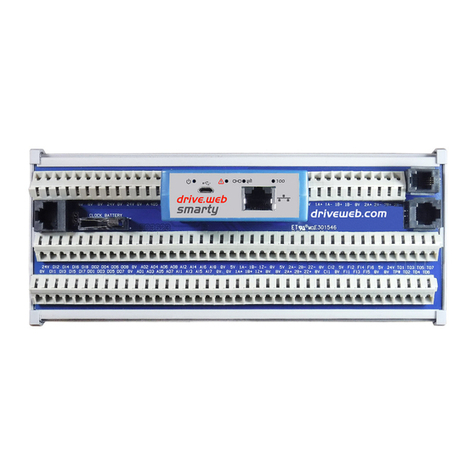
Drive.web
Drive.web smarty dw24 Series Installation & operation manual
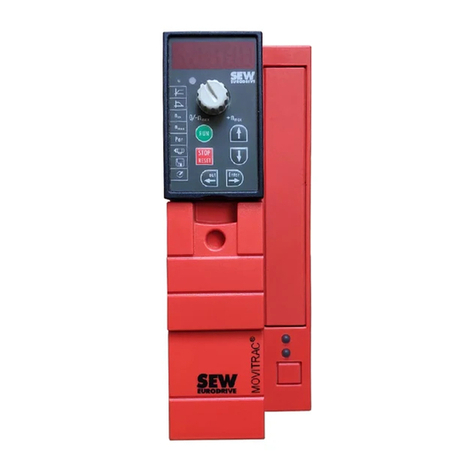
SEW-Eurodrive
SEW-Eurodrive MOVI-PLC basic DHP11B-T0 manual

Elko
Elko iNELS AirSLC-100NB/NEMA/DALI operating instructions
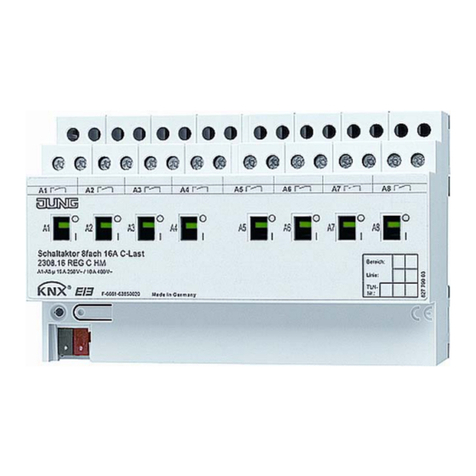
Jung
Jung KNX 230 .16 REGHM Series Operation instructions
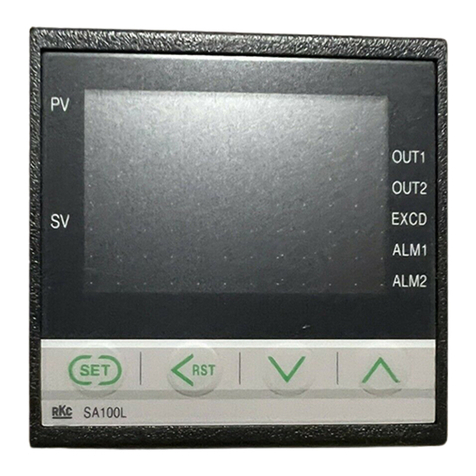
RKC INSTRUMENT
RKC INSTRUMENT SA100L instruction manual
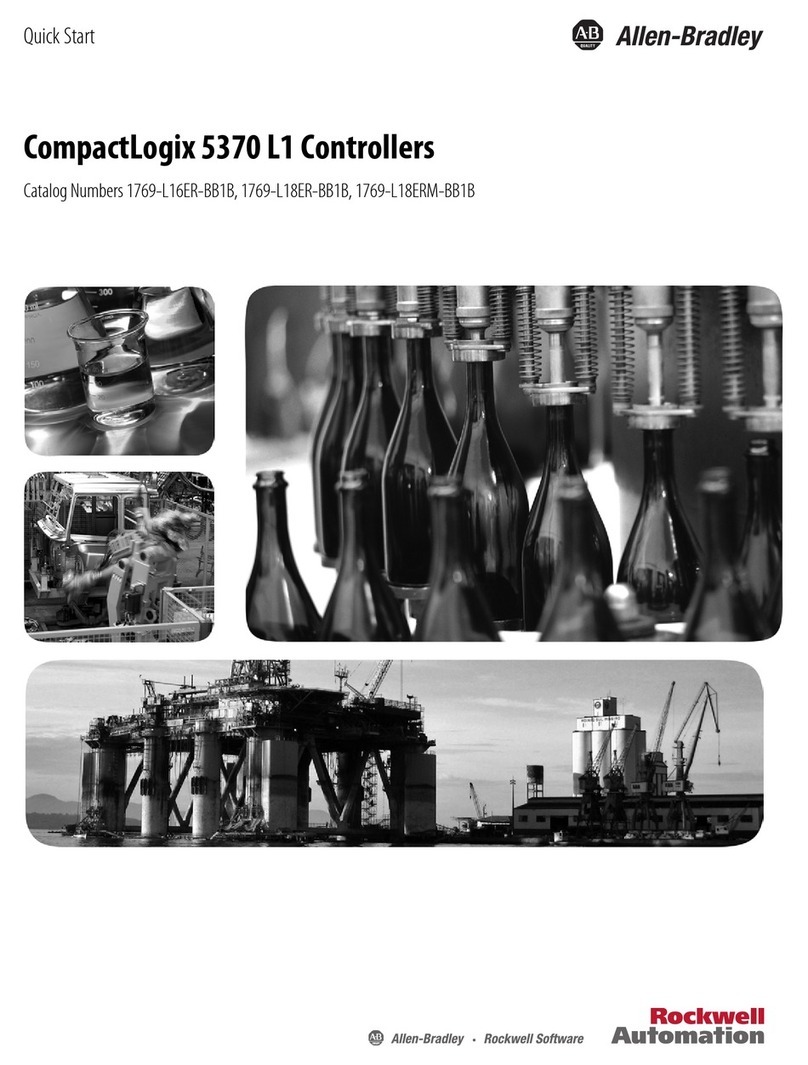
Allen-Bradley
Allen-Bradley CompactLogix 5370 L1 quick start
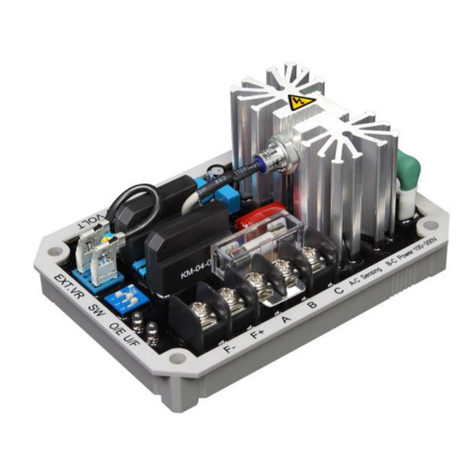
Kutai electronics
Kutai electronics ADVR-053 Operation manual
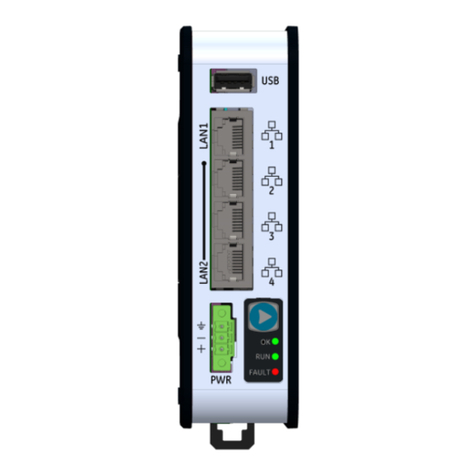
Emerson
Emerson PACSystems RSTi-EP quick start guide
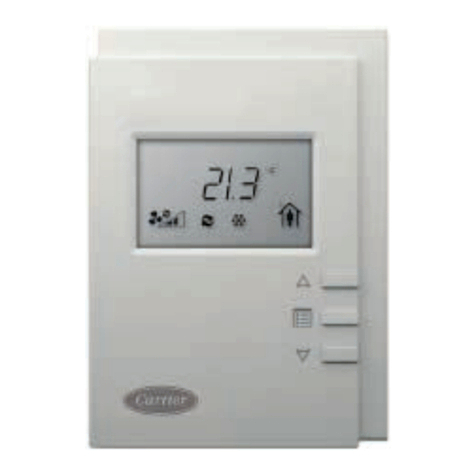
Carrier
Carrier WTC-RCI-DC Series manual
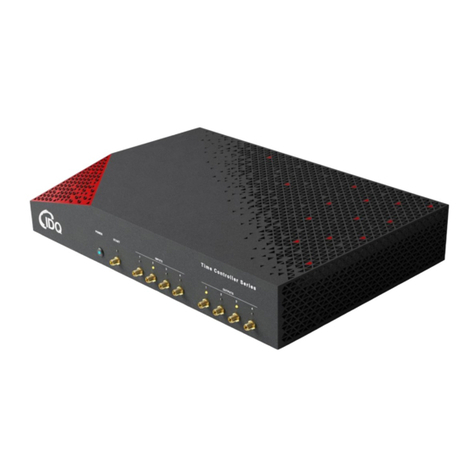
Id Quantique
Id Quantique SWISS QUANTUM+ Time Controller Series user manual
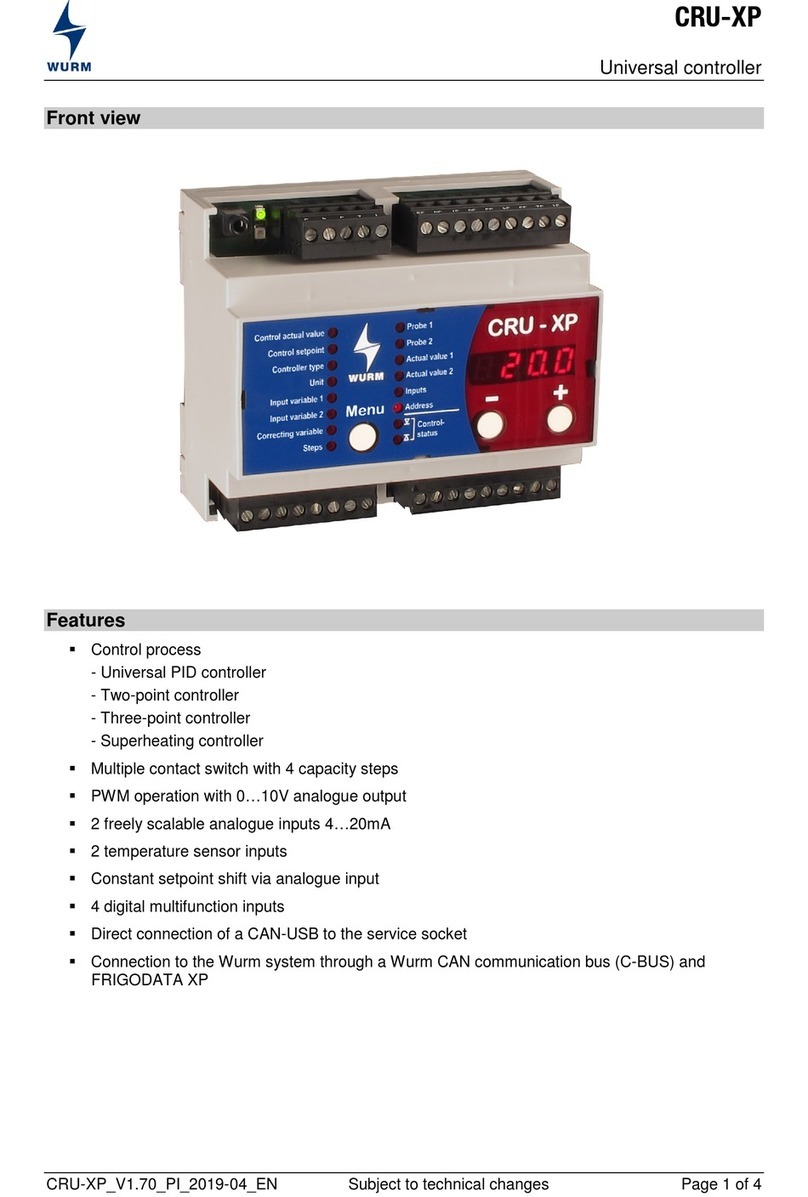
WURM
WURM CRU-XP manual

Hubbell
Hubbell Electric Fire Pump Controllers LXi 2800 Specifications

